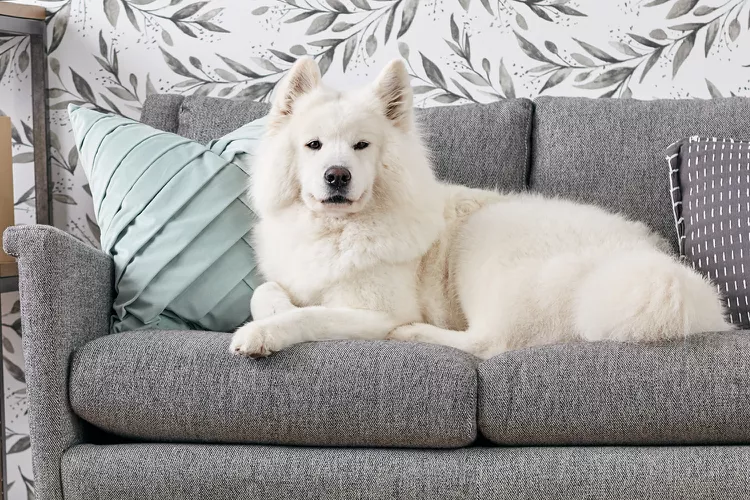Should Dogs Be Allowed on Furniture?

Should you allow your dog to get on the couch? Is it okay to let your dog sleep in your bed? Should dogs be allowed on furniture at all? These are pressing questions for many dog owners. There are plenty of us who allow our dogs on all the furniture in the house. We're the types of animal lovers who pick out furniture with our pets in mind. However, there are also plenty of people who think dogs should not be allowed on the bed and sofa. For some, it's simply a personal preference. Others believe it can cause aggression or other behavior issues.
What's a dog lover to do? Is there anything wrong with letting a dog sleep in your bed or get on the couch and other furniture? Probably not. In general, letting your dog on the furniture is unlikely to cause problems, behavioral or otherwise. Dogs love to curl up on the sofa, the bed, and anywhere else that's nice and soft. They also like to spend time in their humans' favorite spots. Ultimately, it is up to you to decide the rules of your household and stand firm. Here is some information to help you decide what's best for your dog and your home.
Behavioral Effects of Dogs on Furniture
Despite what some people believe, allowing your dog on the furniture will not make him think he is in charge. It will not suddenly cause aggression or dominance. However, be careful not to inadvertently reinforce certain behaviors, or you will be sending the wrong message. For example, any dog that growls or snaps at you when you try to sit down should be removed from the furniture. If your dog refuses to move when you approach, he should be removed. Also, if your dog "hogs" the bed or sofa, as many dogs seem to do, he should be taught to move over and make room for you.
Making furniture off-limits can be a temporary or permanent arrangement, depending on your personal preference. You may have trouble sleeping with a dog in the bed, but you still want to let your dog on the couch for cuddles. You can choose when and where your dog will be allowed, but training is an important part of this process. Many owners choose to allow their dogs on furniture only when they are invited up. This can work when you are at home, but it's a different story when you are out. Know that your dog will most likely help himself when he is home alone if he has the run of the house!
Health and Safety Concerns
Many owners prefer to keep their dogs off the furniture because of the mess (e.g., hair, dirt, and debris). Taking this a step further, some people are concerned about the potential for the spread of disease. There are a handful of diseases considered zoonotic, meaning they can be transmitted to humans from animals. A few examples include parasitic infections, fungal infections, and even plague (the latter is very rare). However, if you keep your dog healthy, the risk is very minimal.
Whether or not you allow your dog on the furniture, all dogs should visit the vet every six to 12 months for an overall wellness check-up. There is very little threat from a dog that has been vaccinated, is kept free of fleas, and is regularly checked and/or treated for parasites. You can minimize the germs and debris your dog brings into the house by wiping their paws, spot-cleaning as needed, and ensuring your dog is routinely groomed. Keep your dog clean with occasional baths as needed. Grooming can help reduce shedding. In addition, regular nail trims will help minimize the damage that can be done by claws.
Keeping Your Dog off the Furniture
Even a dog that is allowed on the furniture should have his own special spot, like a dog bed or a crate (ideally both).
To keep your dog from getting on furniture, some basic training is necessary. Begin by teaching your dog the "off" command. Next, he should be taught the "go to your place" command. If your dog tries to jump on the bed or sofa, simply say "off" followed by "go to your place." Reward him when he complies.
It is equally important to be sure your dog does not have access to the furniture while you are away. This is where crate training becomes helpful. While you are gone, keep your dog in the crate or confined in a small room away from the forbidden furniture.
After successful training, you may choose to conditionally allow your dog on some or all furniture. However, he will need to earn it. After all, it is a privilege, not a right. Before jumping on the furniture, your dog should be made to sit. Once he has obeyed one or more commands of your choosing, you can pat the couch or bed, allowing him up. If he oversteps the boundaries, he will need to get off the furniture. You must be consistent for this to be effective, otherwise, your dog cannot understand what you are asking of him.
Some owners prefer to keep their dogs off the furniture as a household rule. This might be for cleanliness, to prevent damage, or for other reasons. As long as he has his own spot, he will be just fine. Be sure everyone in the household understands and enforces the rules. Inconsistency will confuse your dog and make the training process very difficult.